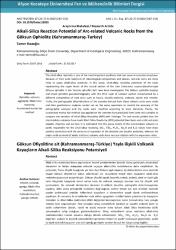Alkali-Silicareaction potential of arc-related volcanic rocks from the göksun ophiolite (Kahramanmaraş-Turkey)
Özet
The alkali-silica reactivity is one of the most important problems that can occur in concrete structures.
Because of their wide spectrum of mineralogical compositions and phases, volcanic rocks are more
likely to cause alkali-silica reactivity. In this study, alkali-silica reactivity potentials of the rocks
representing the upper levels of the crustal section of the Late Cretaceous suprasubduction-type
Göksun ophiolite in the Tauride ophiolitic belt have been investigated. The Göksun ophiolite displays
and intact ophiolite pseudostratigraphy with the thick layer of volcanic section characterized by a
different composition of rock units such as basalt, basaltic-andesite, andesite, dacite and rhyolite.
Firstly, the petrographic determinations of the samples derived from these volcanic units were made
and then geochemical analyzes carried out on the same specimens to control the accuracy of the
petrographic analyzes and the rocks were classified according to trace elements. Finally, the
accelerated mortar bar method was applied on the concrete bars produced from same rock samples to
compare the variation of Alkali-Silica Reactivity (ASR) with lithology. The test results yielded that the
intermediate volcanics have much Alkali Silica Reactivity (ASR) potential than basic and acidic volcanics
(basalts, rhyolites and dacites). It is estimated that the glassy matrix of the intermediate volcanics is
partly responsible for the alkali-silica reactivity. SiO2, TiO2, Al2O3, Na2O and K2O values have show
positive correlation with the amounts of expansion in the andesite and basaltic andesites, whereas the
major oxide contents of acidic and basic volcanic rocks have no clear relation with the expansion ratios. Alkali-silika reaktivitesi beton yapılarda en önemli problemlerden birisidir. Geniş spektrumlu mineralojik
bileşimleri ve fazları dolayısıyla volkanik kayaçlar alkali-silika reaktivitesine daha meyillidirler. Bu
çalışmada, Toros ofiyolit kuşağında yer alan Geç Kretase yaşlı okyanus içi dalma-batma zonu üzerinde
oluşan Göksun ofiyoliti'nin kabuk bölümünün üst seviyelerini temsil eden kayaçların alkali-silika
reaktivite potansiyeli araştırılmıştır. Göksun ofiyoliti bazalt, bazaltik andezit, andezit, dasit ve riyolit gibi
farklı bileşimde kayaçlarla temsil edilen kalın bir volkanik seviyeyle beraber tam bir ofiyolit istifi
sunmaktadır. Bu volkanik birimlerden derlenen örneklerin öncelikle petrografik determinasyonları
yapılmış, daha sonra petrografik analizlerin doğruluğunu kontrol etmek için aynı örnekler üzerinde
yapılan jeokimyasal analizler kullanılarak kayaçların iz elementlere dayalı olarak sınıflandırılması
yapılmştır. En sonunda da örneklerden elde edilen agregalarla üretilen beton çubuklara bu kayaçların
litolojileri ile Alkali-Silika reaktivitesi (ASR) değişimini karşılaştırmak üzere hızlandırılmış harç çubuğu
metodu testi uygulanmıştır. Test sonuçları ortaç volkaniklerin (andezit ve bazaltik andezit) bazik ve
asidik volkaniklere (bazalt, riyolit ve dasit) nazaran daha yüksek Alkali Silica Reaktivitesi (ASR)
potansiyeline sahip olduğunu göstermektedirler. Ortaç volkaniklerin camsı matrisinin alkali-silika
reaktivitesinden kısmen sorumlu olduğu tahmin edilmektedir. SiO2, TiO2, Al2O3, Na2O ve K2O
değerleri, andezit ve bazaltik andezitlerdeki genleşme miktarı ile pozitif korelasyon gösterirken, asidik
ve bazik volkanik kayaçların ana oksit içeriği, genleşme oranları ile açık bir ilişkiye sahip değildir.
Cilt
17Sayı
1Bağlantı
http://fenbildergi.aku.edu.tr/wp-content/uploads/2017/04/015802247-256.pdfhttp://hdl.handle.net/11630/4608
Koleksiyonlar
- Cilt 17 : Sayı 1 [41]



















